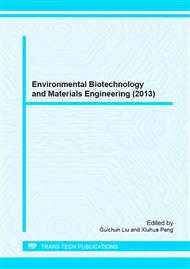[1]
L. Shaolin, W. Hongbin, Z. Dong. The research and the applications of the recycling technology of vehicle washing wastewater, Water Purification Technology. 25(2006) 55-58.
Google Scholar
[2]
H. Chun, A. Taicheng, X. Ya, S. Dong, H. Huiling and Z. Xihai. Electrochemical degradation of organic wastewater by three-dimensional electrode reactor, Electrochemistry. 8(2002) 327-332.
Google Scholar
[3]
E. Fockedey, A. Van Lierde. Coupling of anodic and cathodic reactions for phenol electro-oxidation using three-dimensional electrodes. Water Res. 36(2002) 4169-4175.
DOI: 10.1016/s0043-1354(02)00103-3
Google Scholar
[4]
W. li, Z. Derui. Treatment of effluent containing Cu ion by composite three dimension electrochemistry reactor. Journal of Wuhan University of Technology. 26(2004) 19-21.
Google Scholar
[5]
M. Panizza, C. Bocca, G. Cerisola. Electrochemical treatment of wastewater containing polyaromatic organic pollutants, Water Res. 34(2000) 2601-2605.
DOI: 10.1016/s0043-1354(00)00145-7
Google Scholar
[6]
X. Rongchun, J. Chenggong, W. gang. Treatment of dyestuffs wastewater with two and three-dimension electrode methods, Journal of Benjing University of Chemical Technology . 29(2002) 34-37.
Google Scholar
[7]
Y. song, L. yunming, Z. jiti and H. jun. Treatment of aniline using three-dimensional three-phase fluidized bed electrode, Techniques and Equipment for Environmental Pollution Control. 5(2004) 43-47.
Google Scholar
[8]
Y. Xiong, H.T. Karlsson. An experimental investigation of chemical oxygen demand removal from the wastewater containing oxalic acid using three-phase three-dimensional electrode reactor, Adv Environ Res. 7(2002) 139-145.
DOI: 10.1016/s1093-0191(01)00124-1
Google Scholar
[9]
C. Wu, Y. Changzhu, M. Ping, D. Lingling and Y. Gu. Study on the treatment of dying wastewater by using three dimensional electrode electrochemical method, Industrial Water Treatment. 24(2004) 43-45.
Google Scholar
[10]
C. Wu, L. Fanxiu, M. Ping. Development of Studying on Electrochemical Methods in Treating Wastewater, Hubei Chemical Industry. 18(2001) 10-12.
Google Scholar
[11]
National Environmental Protection Agency water and wastewater monitoring and analysis methods Editorial Board, Water and wastewater monitoring and analysis methods, China Environmental Science Press,; Beijing , (2002).
Google Scholar
[12]
W. Lizhang, Q. Rongchu, H. Yiliang. Study on application of three-dimensional-electrode method in treating low contaminated wastewater. Techniques and Equipment for Environmental Pollution Control. 4(2003) 28-76.
Google Scholar
[13]
L. Zhao e, The principles and applications of the electrode process, Higher Education Press, Beijing, (1992).
Google Scholar
[14]
H. Guojian,L. Xiaobo,W. deguan. Treatment of dying wastewater by three-dimensional electrode process, Environmental Protection of Chemical Industry. 24(2004) 124-127.
Google Scholar
[15]
K. Shenglu, Applied Electrochemistry, Huazhong University of Science and Technology Press, Wuhan, (1994).
Google Scholar
[16]
E.A. Vik, D.A. Carlson, A.S. Eikum and E.T. Gjessing. Electrocoagulation of potable waterWater Res. 18(1984) 1355-1360.
DOI: 10.1016/0043-1354(84)90003-4
Google Scholar


